U.S. Department of the Interior
U.S. Geological Survey
Fact Sheet 2004–3031
March 2004
The USGS laser-ablation inductively coupled plasma-mass spectrometer (LA-ICP-MS) is being used as a tool to analyze mining-related activities that impact element levels in mine drainage. Historical metal-release events potentially may be determined by using tree rings as the sample medium (each ring representing a fixed point in time) and the LA-ICP-MS as the analytical tool. This approach has been used successfully by the USGS at the abandoned Waldorf Mine, Colorado, (Witte and others1). Tree cores from ponderosa pine and gray pine (Pinus ponderosa and P. sabiniana, respectively) also are being collected at selected abandoned mining sites in California and analyzed for the total concentration of the stable isotopes of Cd, Cu, Cr, Fe, Mg, Mn, Pb, Sr, and Zn. The purpose of the studies is to assess the utility of tree ring xylem (wood) analyses for measuring mining-related episodic events such as temporal changes in ground- and surface-water element loadings. The premise is that elements available for absorption by trees are "fixed" in the xylem tissue (tree ring) produced in that particular year. Theoretically, therefore, it should be possible to "date" changes in the uptake of elements. The LA-ICP-MS is a particularly powerful tool in this regard because it is capable of analyzing for a variety of elements over very small (100 μm, 1x10-4 m, or less) areas within the tree ring. This capability is unlike older analytical methods that consume large volumes of sample material and that usually require compositing the tissue from numerous rings. Preliminary results indicate that LA-ICP-MS provides a repeatable, minimally destructive, sensitive method for determining many elements in wood tissue, with relatively high spatial resolution.
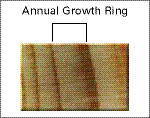
Cores were extracted from opposite sides of the tree, 30 cm above ground level, and were stored in rigid paper "soda" straws until dry. Following age-dating, one surface of the core was sanded flat, sectioned, and mounted for insertion into the LA-ICP-MS instrument. Analysis of the core followed the method described in the cartoon (next page). The laser is set so that seven analyses (spots), each 100 μm in diameter, are made equidistant from each other across an annual ring—the broader the ring, the further apart the spots. The seven spots integrate any differences in the ring that may be the result of earlywood versus latewood—an issue found to be important in some of our earlier studies. Integration yields one average value for the seven spots. Analysis then is made of the variability in the element concentrations among analyses within a ring, among rings within a core, and between cores taken within a tree.
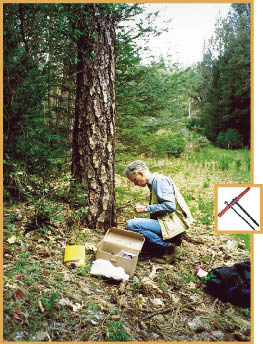
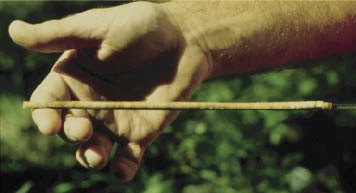
Intensity (counts per second) is converted to concentrations by using a commercially available package, GeoPro™ (CETAC Technologies, Omaha, Nebr.). The area of the peak of interest is selected, and the blank for that peak is subtracted. Based on the analysis of a standard (usually run 3–5 times before and after each block of analyses), a calibration curve is constructed and the intensity of the sample is converted to concentration. This concentration then is normalized against a known element in the sample, in this case C. The robustness of the analysis relies on the degree of confidence and the homogeneity of the standard.
Evaluation of the absolute accuracy and precision of the LA-ICP-MS technique relies on carefully characterized standards. In the case of whole-sample techniques, the standards need to be homogeneous at a scale finer than the resolution of the analyses. For quantitative measurements, 13C is used as an internal standard (pressed pellets of purified cellulose doped with major and trace elements are used for calibration), and National Institute of Standards and Technology standard reference materials were used as secondary standards.
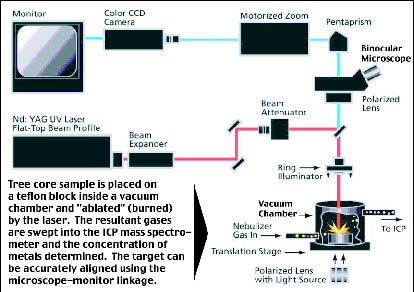
MASS SPECTROMETER: Perkin Elmer 6000 ICP-MS
Laser System (and settings used in this study)–CETAC LSX 200+
Frequency quadrupled Q-switched Nd:YAG laser, 266 nm
Real-time imaging in transmitted and reflected light
Flow-controlled Ar+He carrier gas
Variable laser pulse repetition rate (pulse rate used: 20 Hz)
Adjustable spot size (spot size used: 100 μm)
Computer controlled ablation methods of spots, lines, scanning areas, and raster of spots (single-line raster used)
Each analysis represents the integration of data from seven 100 μm-diameter "spots"
(craters) equally spaced across the ring (laser pulse rate: 20 pulses/sec.)
Element isotopes measured: 13C, 111Cd, 65Cu, 52Cr, 57Fe, 24Mg, 55Mn, 208Pb, 88Sr, and 66Zn.
With this new laser ablation technique it now is possible to determine the variability in the analytical data within and between cores (and within and between trees). This type of information is critical to know before conclusions can be made regarding the use of the data to date element contamination episodes. For example, if duplicate analyses within a tree ring indicate excessively large differences in results within a given year (see the error bars for the analyses of Cd in gray pine on last page), possible differences between years (rings) cannot be assessed. In contrast, the variability in the data for Cr in gray pine for a particular year is very small, which makes possible the interpretation of trends between years. The example of Cd in gray pine also is good for demonstrating how different the chemistry of two cores can be that are taken from the same tree. The data for Cd in gray pine could never be used to assess element uptake trends over time; there is simply too much variability in the data within and between rings and cores.
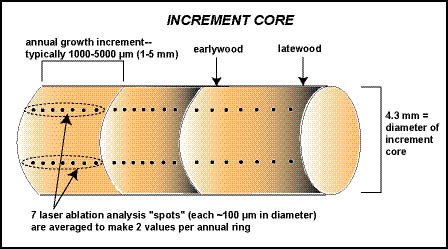
In contrast, a number of different conclusions can be drawn from the plots for the element concentrations in ponderosa pine. First, except for perhaps Cr, the concentrations are much less than those in the gray pine (the left-hand vertical scales in the figures above are the same for both trees). (One reason for this is probably because the gray pine had its roots in mine tailings [shown last page] that were rich in available elements, whereas the ponderosa pine did not.) The variability shown between analyses within a ponderosa pine ring is small (small error bars), making comparisons between rings possible; the comparison of the data between cores also is quite good (the r2 values are significant for all tree elements shown). For this tree species at this site it should be possible to assess yearly trends in element uptake.
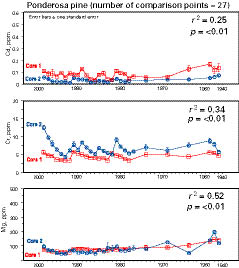
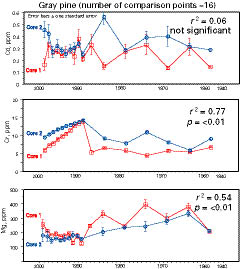
A further complication is the possibility that metals may migrate between individual rings and thus are not "fixed" within the tissue of a specific ring. This condition would complicate the interpretation of differences between tree rings tremendously. For example, some plants are known to physiologically transport excess metals (or potentially toxic metals) from the roots to leaves and are not "fixed" in the woody tissue. With the shedding of leaves during fall leaf-drop, the metals also are shed, thus protecting the plant from a buildup of potentially harmful metals (elements).
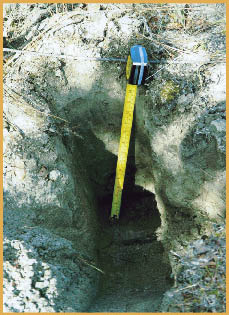
Larry Gough
U.S. Geological Survey
4200 University Dr.
Anchorage, AK 99508
Telephone 907-786-7441
e-mail: lgough@usgs.gov
Ian Ridley
U.S. Geological Survey
Denver Federal Center, MS 973
Denver, CO 80225
Telephone 303-236-5558
e-mail: iridley@usgs.gov
or visit website URL:
http://minerals.cr.usgs.gov/icpms/
Document Accessibility: Adobe Systems Incorporated has information about PDFs and the visually impaired. This information provides tools to help make PDF files accessible. These tools convert Adobe PDF documents into HTML or ASCII text, which then can be read by a number of common screen-reading programs that synthesize text as audible speech. In addition, an accessible version of Acrobat Reader 6.0, which contains support for screen readers, is available. These tools and the accessible reader may be obtained free from Adobe at Adobe Access.
| AccessibilityFOIAPrivacyPolicies and Notices | |
| |
|